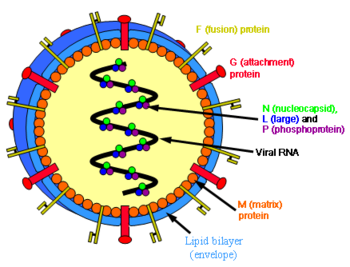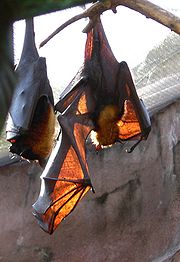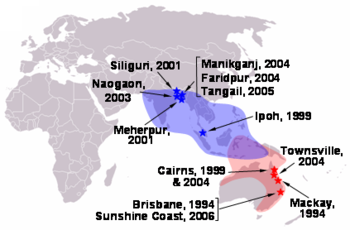
Henipavirus
Background to the schools Wikipedia
SOS Children, an education charity, organised this selection. Click here to find out about child sponsorship.
| Henipaviruses | |
|---|---|
| Virus classification | |
| Group: | Group V ( (-)ssRNA) |
| Order: | Mononegavirales |
| Family: | Paramyxoviridae |
| Genus: | Henipavirus |
| Type species | |
| Hendravirus |
|
| Species | |
Henipavirus is a genus of the family Paramyxoviridae, order Mononegavirales containing two members, Hendravirus and Nipahvirus. The henipaviruses are naturally harboured by Pteropid fruit bats (flying foxes) and are characterised by a large genome, a wide host range and their recent emergence as zoonotic pathogens capable of causing illness and death in domestic animals and humans.
Virus structure
Henipaviruses are pleomorphic (variably shaped), ranging in size from 40 to 600 nm in diameter. They possess a lipid membrane overlying a shell of viral matrix protein. At the core is a single helical strand of genomic RNA tightly bound to N (nucleocapsid) protein and associated with the L (large) and P (phosphoprotein) proteins which provide RNA polymerase activity during replication.
Embedded within the lipid membrane are spikes of F (fusion) protein trimers and G (attachment) protein tetramers. The function of the G protein is to attach the virus to the surface of a host cell via ephrin B2, a highly conserved protein present in many mammals. The F protein fuses the viral membrane with the host cell membrane, releasing the virion contents into the cell. It also causes infected cells to fuse with neighbouring cells to form large, multinucleated syncytia.
Genome structure
As with all viruses in the Mononegavirales order, the Hendra virus and Nipah virus genomes are non-segmented, single-stranded negative-sense RNA. Both genomes are 18.2 kb in size and contain six genes corresponding to six structural proteins.
In common with other members of the Paramyxovirinae subfamily, the number of nucleotides in the henipavirus genome is a multiple of six, known as the 'rule of six'. Deviation from the rule of six, through mutation or incomplete genome synthesis, leads to inefficient viral replication, probably due to structural constraints imposed by the binding between the RNA and the N protein.
Henipaviruses employ an unusual process called RNA editing to generate multiple proteins from a single gene. The process involves the insertion of extra guanosine residues into the P gene mRNA prior to translation. The number of residues added determines whether the P, V or W proteins are synthesised. The functions of the V and W proteins are unknown, but they may be involved in disrupting host antiviral mechanisms.
Hendra virus
Emergence
Hendra virus (originally Equine morbillivirus) was discovered in September 1994 when it caused the deaths of fourteen horses, and a trainer at a training complex in Hendra, a suburb of Brisbane in Queensland, Australia.
The index case, a mare, was housed with 23 other horses after falling ill and died two days later. Subsequently, 19 of the remaining horses succumbed with 13 dying. Both the trainer and a stable hand were involved in nursing the index case and both fell ill within one week of the horse’s death with an influenza-like illness. The stable hand recovered while the trainer died of respiratory and renal failure. The source of virus was most likely frothy nasal discharge from the index case.
A second outbreak occurred in August 1994 (chronologically preceding the first outbreak) in Mackay 1000km north of Brisbane resulting in the deaths of two horses and their owner. The owner assisted in autopsies of the horses and within three weeks was admitted to hospital suffering from meningitis. He recovered, but 14 months later developed neurologic signs and died. This outbreak was diagnosed retrospectively by the presence of Hendra virus in the brain of the patient.
A survey of wildlife in the outbreak areas was conducted and identified pteropid fruit bats as the most likely source of Hendra virus with a seroprevalence of 47%. All of the other 46 species sampled were negative. Virus isolations from the reproductive tract and urine of wild bats indicated that transmission to horses may have occurred via exposure to bat urine or birthing fluids..
Outbreaks
A total of eight outbreaks of Hendra virus have occurred since 1994, all involving infection of horses. Four of these outbreaks have spread to humans as a result of direct contact with infected horses.
- August 1994, Mackay, Queensland: Death of two horses and one person.
- September 1994, Brisbane, Queensland: 14 horses died from a total of 20 infected. Two people infected with one death.
- January 1999, Cairns, Queensland: Death of one horse.
- October 2004, Cairns, Queensland: Death of one horse. A vet involved in autopsy of the horse was infected with Hendra virus and suffered a mild illness.
- December 2004, Townsville, Queensland: Death of one horse.
- June 2006, Sunshine Coast, Queensland: Death of one horse.
- July 2008, Brisbane, Queensland: Infection of three horses with one death. A veterinary worker from the affected property tested positive to antibodies to Hendra virus.
- July 2008, Cannonvale, Queensland: Death of one horse.
The distribution of black and spectacled flying foxes covers the outbreak sites, and the timing of incidents indicates a seasonal pattern of outbreaks possibly related to the seasonality of fruit bat birthing. As there is no evidence of transmission to humans directly from bats, it is thought that human infection only occurs via an intermediate host.
Pathology
Flying foxes are unaffected by Hendra virus infection. Symptoms of Hendra virus infection of humans may be respiratory, including haemorrhage and oedema of the lungs, or encephalitic resulting in meningitis. In horses, infection usually causes pulmonary oedema and congestion.
Nipah virus
Emergence
Nipah virus was identified in 1999 when it caused an outbreak of neurological and respiratory disease on pig farms in peninsular Malaysia, resulting in 105 human deaths and the culling of one million pigs. In Singapore, 11 cases including one death occurred in abattoir workers exposed to pigs imported from the affected Malaysian farms. The Nipah virus has been classified by the CDC as a Category C agent ( http://www.bt.cdc.gov/agent/agentlist-category.asp).
Symptoms of infection from the Malaysian outbreak were primarily encephalitic in humans and respiratory in pigs. Later outbreaks have caused respiratory illness in humans, increasing the likelihood of human-to-human transmission and indicating the existence of more dangerous strains of the virus.
Based on seroprevalence data and virus isolations, the primary reservoir for Nipah virus was identified as Pteropid fruit bats including Pteropus vampyrus (Malayan flying fox) and Pteropus hypomelanus (Island flying fox), both of which occur in Malaysia.
The transmission of Nipah virus from flying foxes to pigs is thought to be due to an increasing overlap between bat habitats and piggeries in peninsular Malaysia. At the index farm, fruit orchards were in close proximity to the piggery, allowing the spillage of urine, faeces and partially eaten fruit onto the pigs. Retrospective studies demonstrate that viral spillover into pigs may have been occurring in Malaysia since 1996 without detection. During 1998, viral spread was aided by the transfer of infected pigs to other farms where new outbreaks occurred.
Outbreaks
Eight more outbreaks of Nipah virus have occurred since 1998, all within Bangladesh and neighbouring parts of India. The outbreak sites lie within the range of Pteropus species (Pteropus giganteus). As with Hendra virus, the timing of the outbreaks indicates a seasonal effect.
- 2001 January 31 – February 23, Siliguri, India: 66 cases with a 74% mortality rate. 75% of patients were either hospital staff or had visited one of the other patients in hospital, indicating person-to-person transmission.
- 2001 April – May, Meherpur district, Bangladesh: 13 cases with nine fatalities (69% mortality).
- 2003 January, Naogaon district, Bangladesh: 12 cases with eight fatalities (67% mortality).
- 2004 January – February, Manikganj and Rajbari provinces, Bangladesh: 42 cases with 14 fatalities (33% mortality).
- 2004 19 February – 16 April, Faridpur district, Bangladesh: 36 cases with 27 fatalities (75% mortality). Epidemiological evidence strongly suggests that this outbreak involved person-to-person transmission of Nipah virus, which had not previously been confirmed. 92% of cases involved close contact with at least one other person infected with Nipah virus. Two cases involved a single short exposure to an ill patient, including a rickshaw driver who transported a patient to hospital. In addition, at least six cases involved acute respiratory distress syndrome which has not been reported previously for Nipah virus illness in humans. This symptom is likely to have assisted human-to-human transmission through large droplet dispersal.
- 2005 January, Tangail district, Bangladesh: 12 cases with 11 fatalities (92% mortality). The virus was probably contracted from drinking date palm juice contaminated by fruit bat droppings or saliva.
- 2007 February – May, Nadia District, India: up to 50 suspected cases with 3-5 fatalities. The outbreak site borders the Bangladesh district of Kushtia where eight cases of Nipah virus encephalitis with five fatalities occurred during March and April 2007. This was preceded by an outbreak in Thakurgaon during January and February affecting seven people with three deaths. All three outbreaks showed evidence of person-to-person transmission.
- 2008 February - March, Manikganj and Rajbari provinces, Bangladesh: Nine cases with eight fatalities.
Eleven isolated cases of Nipah virus encephalitis have also been documented in Bangladesh since 2001.
Nipah virus has been isolated from Lyle's flying fox (Pteropus lylei) in Cambodia and viral RNA found in urine and saliva from P. lylei and Horsfield's roundleaf bat (Hipposideros larvartus) in Thailand. Infective virus has also been isolated from environmental samples of bat urine and partially-eaten fruit in Malaysia. Antibodies to henipaviruses have also been found in fruit bats (Pteropus rufus, Eidolon dupreanum) in Madagascar indicating a wide geographic distribution of the viruses. No infection of humans or other species have been observed in Cambodia, Thailand or Madagascar.
Pathology
In humans, the infection presents as fever, headache and drowsiness. Cough, abdominal pain, nausea, vomiting, weakness, problems with swallowing and blurred vision are relatively common. About a quarter of the patients have seizures and about 60% become comatose and might need mechanical ventilation. In patients with severe disease, their conscious state may deteriorate and they may develop severe hypertension, fast heart rate, and very high temperature.
Nipah virus is also known to cause relapse encephalitis. In the initial Malaysian outbreak, a patient presented with relapse encephalitis some 53 months after his initial infection. There is no definitive treatment for Nipah encephalitis, apart from supportive measures, such as mechanical ventilation and prevention of secondary infection. Ribavirin, an antiviral drug, was tested in the Malaysian outbreak and the results were encouraging, though further studies are still needed.
In animals, especially in pigs, the virus causes porcine respiratory and neurologic syndrome also known as barking pig syndrome or one mile cough.
Causes of Emergence
The emergence of henipaviruses parallels the emergence of other zoonotic viruses in recent decades. SARS coronavirus, Australian bat lyssavirus, Menangle virus and probably Ebola virus and Marburg virus are also harbored by bats and are capable of infecting a variety of other species. The emergence of each of these viruses has been linked to an increase in contact between bats and humans, sometimes involving an intermediate domestic animal host. The increased contact is driven both by human encroachment into the bats’ territory (in the case of Nipah, specifically pigpens in said territory) and by movement of bats towards human populations due to changes in food distribution and loss of habitat.
There is evidence of habitat loss for flying foxes both in South Asia and Australia (particularly along the east coast) as well as encroachment of human dwellings and agriculture into the remaining habitats, creating greater overlap of human and flying fox distributions.





